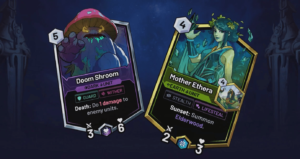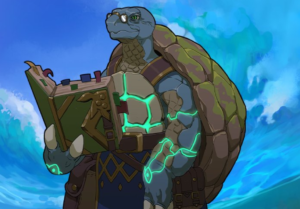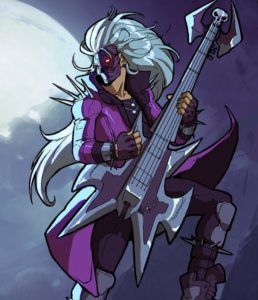MissaurusRex’s Complete Beginner’s Guide to Skyweaver – Part 3
Welcome to part 3 of my comprehensive Skyweaver beginner guide. If you missed the previous parts, be sure to check the links to the other parts of my guide:
⦁ Overview of the Skyweaver interfaces, cards, and game modes
⦁ Overview of Heroes/Prisms and understanding card phrasing
⦁ Core game mechanics, and “out-of-decking”/conjuring
⦁ The attachment system & enchantments
⦁ Playing the game and turn order
⦁ Deck building for beginners
By this point you should be familiar with card phrasing, and have a solid understanding of the types of cards and Heros/Prisms that exist in Skyweaver. I recommend also watching this video guide in its entirety to see examples in real-time. In this guide we’re going to get into the core game mechanics and review:
⦁ Card Traits
⦁ Card Triggers
⦁ Out of decking/conjuring
A card’s traits refer to the keywords it has. Both units and spells have keywords that changes certain features of the card. Some units or spells have multiple keywords, and some cards can give keywords to units or spells. I’m going to list and define each keyword below and mention important things to keep in mind. I will also provide analogues to other card games where possible. The official site also has a post on keywords.
Armor: Takes 1 less damage from everything.
Armor prevents 1 damage to a character whenever that character would take damage. This means it will reduce 1 damage sources to 0.
Similar to: Tough in Runeterra, Magic and Hearthstone do not have Armor equivalents.
Banner: Your hero gains +1 power.
Banner is a stackable ability, and for each unit you have, or for each spell you use with banner, your Hero will gain +1 power. For spells, however, you only have Banner on the turn you used the spell. Heros can also be given the keyword Banner by certain cards.
Similar to: There are no equivalents in Runeterra, Magic, or Hearthstone.
Dash: This unit can attack enemy units the turn it is summoned, or if it was sleeping and gained dash.
Dash means that a unit can attack enemy units the turn it is summoned. This different from readied, as a readied unit can attack units or heroes. Dash can also be given to units who do not already have dash, which will give it the ability to attack enemy units. It is important to keep in mind that a unit with roots cannot attack, or a unit that has already attacked cannot attack again if given dash.
Similar to: Rush in hearthstone. Magic only has haste which is like charge in Hearthstone, and there is no Runeterra equivalent.
Guard: This unit’s hero can’t be attacked.
Units with Guard protect your Hero from attacks. It will not protect un-stealthed units. Units with guard will always be placed to the right of your Hero.
Similar to: Taunt in Hearthstone, but Taunt protects both minions and Heros, so keep that in mind. There are no equivalents in Runeterra or Magic.
Lifesteal: When this damages the enemy Hero, give your hero that much health.
You only gain health when you damage the enemy Hero with lifesteal units or spells.
Similar to: Lifesteal in Runeterra and Hearthstone, and Lifelink in Magic. In these card games, units or spells with Lifesteal/Lifelink will heal you if they damage units on the battlefield. Lifesteal in Skyweaver only applies when you deal damage to the enemy Hero.
Stealth: This unit can’t be attacked unless its Hero has been damaged this turn.
Units with stealth cannot be attacked until their Hero has been damaged by a unit, hero, or spell in the same turn. Units that have been un-stealthed will regain their stealth at the end of the turn if they are still on the battlefield. Guard can be used to protect your stealth units from unit attacks, because if you can prevent damage to your Hero it will keep your units with stealth active. Units with Stealth are not protected from spells. Units with stealth are always placed to the left of your Hero, but to the right of those without Stealth.
Similar to: Stealth in Hearthstone, but it works a bit differently. Units with Stealth in Hearthstone cannot be the target of enemy attacks, spells or abilities until that unit attacks or deals damage, and then they lose stealth forever. There are no equivalents in Runeterra or Magic.
Wither: When this damages a unit, that unit loses that much power.
Whenever a unit, spell, or hero, with Wither deals damage to a unit, it will damage both the unit’s health and power. Wither does not reduce the damage of a Hero.
Similar to: There are no equivalents in Hearthstone or Runeterra. Wither in Magic is slightly different, and damage dealt to units is done in the form of -1/-1 counters.
A card’s trigger refers to various effects that the card can trigger to happen. Both units and spells can have card triggers. For the most part, cards only have 1 trigger. Depending on the trigger, it can be activated multiple times per turn. I will list and define each one below:
Play: When this unit is played from hand.Note: Does not activate if the unit is brought into the battlefield from anywhere other than your hand.
Summon: When this unit comes into play.Note: This activates if the unit is brought into the battlefield from anywhere.
Inspire X: When you play a card with a particular quality, the card’s written effect will trigger.Note: This includes attachments and playable enchantments.
Glory: When this unit attacks and damages a hero, the card’s written effect will trigger.
Sunset: When this player’s turn ends, the card’s written effect will trigger.
Sunrise: When this player’s turn starts, the card’s written effect will trigger.Note: Sunrise and Sunset can be the most confusing for new players. The effects only happen to the player with the sunrise/sunset effect on that player’s turn. If you play magic, sunrise/sunset are the equivalent to a player’s upkeep and end step phases.
Mulligan: Return cards from your hand to your deck, then draw the same number of cards that were in your hand.
Draw: Draw a card from your deck, if possible. If not, lose 1 health and conjure one instead (more on this soon).
Dust: Remove from the game.Note: Dust means a unit/spell does not enter the graveyard, so death effects are not triggered. Units/spells can also be dusted from the graveyard.
Death: When this dies, the card’s written effect will trigger.Note: In order for a unit to be considered dead, it must enter the graveyard.
Skyweaver has a mechanic that allows you to draw cards that are not in your deck. When you have a card that allows you to draw, one would usually look at their decklist to see what cards they could potentially draw. If you do not have something to draw from your deck you will draw a card from your Prisms, but not from your deck, at the cost of -1 health. If there is nothing possible for you to draw, you will not draw a card or lose 1 health. This process is semi-random, as there are a few things that determine what card you will draw from out or your deck:
⦁ What the card specifies you will draw
⦁ What Prism(s)/Hero you’re playing
⦁ What cards that belong to your hero that exist in play
Let me walk you through an example. If I’m playing Ada (Str Hero) and I play Call to Action, this card allows me to draw a 1 cost unit. If there are no 1 cost units in my deck, I will draw a 1 cost Strength unit and lose 1 health. If I’ve played an Amalgam and an Axolotl is in my hand, I will draw a random card from the remaining available 1 cost units in Strength. If every 1 cost unit possible in Strength is in play, so either in my hand, in the graveyard (or has been dusted), or on the battlefield, I will not draw a card or lose health.
When you Conjure a card, the same rules applying as OOD the only difference is that you do not lose health. While OOD is random at the surface, the drawing can be manipulated in deck building. For example, if you were playing Strength (Ada) and put every earth unit in the deck except for Redwood and Sabletooth, and you have no more earth units in your deck, if you play the card Ethermask you will draw Redwood and Sabletooth, since those are the only cards possible for you to draw. If you’re playing discovery and you have knowledge of the cards that are in the Prism(s) you’re playing, you can have an idea of the card you can draw from outside your deck, giving you a huge advantage over your opponent.
That’s all for this guide! By this point you almost know everything there is to know about Skyweaver.







1 thought on “MissaurusRex’s Complete Beginner’s Guide to Skyweaver – Part 3”